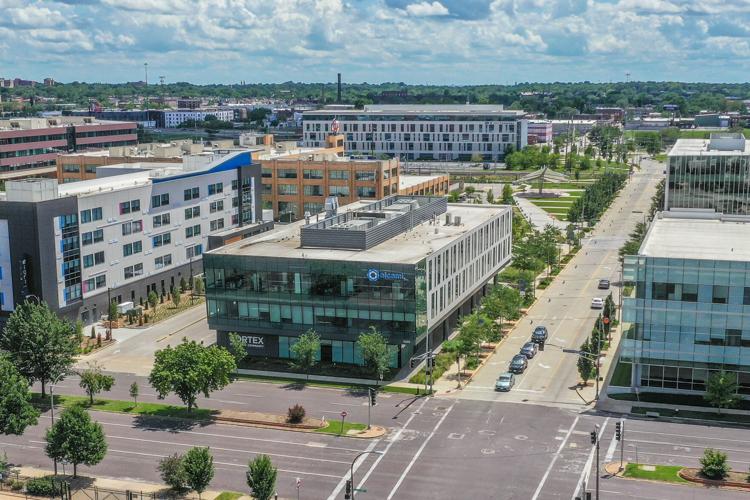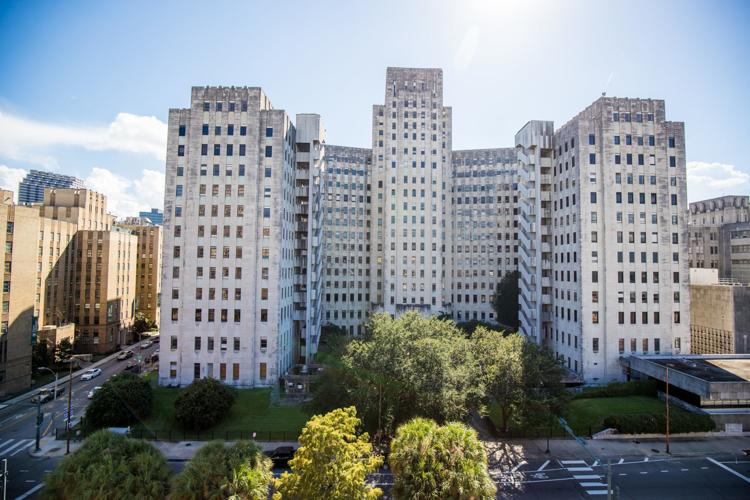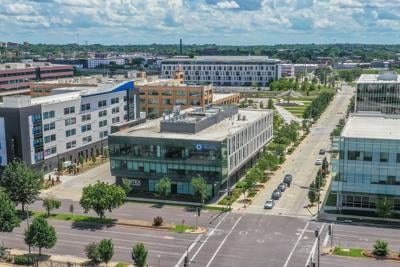In pitching for a taxpayer-funded bioscience district in New Orleans, city officials and other supporters have frequently pointed to a similar initiative in St. Louis that's widely recognized as a model of success.
The St. Louis Cortex Innovation Community, which began in 2002, had many of the same goals that BioDistrict New Orleans has set for itself. They were: attract biosciences companies to the city; create thousands of high-paying jobs; and become “the most racially, ethnically and gender-inclusive district in the country.”
Cortex has succeeded spectacularly on the first two goals, attracting more than 400 companies to its 200 acres in St. Louis' Central West End. So far, it has created 6,000 jobs and in 2018 generated nearly $70 million in new tax revenue for the city and state.
There are a number of similarities in how the BioDistrict proposes to achieve its goals, but also key differences that some experts worry could be potential stumbling blocks.

The originally-proposed BioDistrict covered about 1,500 acres and was bounded by Carrollton Avenue, Iberville Street, Loyola Avenue and Earhart Boulevard. The revised version takes out almost all the residential neighborhoods to overcome objections.
The BioDistrict is a state entity that is mandated to help grow the bioscience industry across a 1,200-acre stretch of downtown New Orleans, an area that includes some vibrant neighborhoods and commercial areas. Created in 2005, it has remained moribund ever since for lack of funding and political backing.
But in recent years, business and civic leaders have turned back to the agency for its potential to help bring companies and high-paying jobs to the area that contains University Medical Center, Xavier University, the New Orleans BioInnovation Center, Tulane Medical Center and the old Charity Hospital.
It is run by a 15-member board made up of city, state, and government agency appointees, as well as representatives of local universities. And its backers, led by board chairman and Greater New Orleans Foundation CEO Andy Kopplin, are asking for City Council approval to take a 2% share of incremental city and state sales tax revenue generated in the district over the next 20 years.

UMC, University Medical Center New Orleans, photographed Tuesday, March 3, 2020. (Photo by David Grunfeld, NOLA.com, The Times-Picayune | The New Orleans Advocate)
How much this would bring in is hard to predict as it depends on how sales tax revenue in the district grows. But the BioDistrict estimates it would grow from about $75,000 in its first year to more than $14 million in its final year, bringing in a total of $71 million.
Cortex was set up as a private sector non-profit organization with a mandate to redevelop an area one-sixth the size of the BioDistrict. The area was largely abandoned industrial sites and blighted residential property.
It got $29 million in initial funding from four of its five founding institutions. Washington University kicked in $15 million; BJC HealthCare and St. Louis University each put up $5 million; and the University of Missouri - St. Louis added $4 million.
With private-sector backing in place, the St. Louis city administration then designated the area a redevelopment district and named Cortex its master developer. That allowed Cortex to provide tax abatements to stimulate development, use eminent domain powers and secure state tax credits and federal grants.

The former Charity Hospital on Tulane Avenue would be at the center of the proposed BioDistrict. It is set for a $300 million rehabilitation, with Tulane University as its anchor tenant. When completed, the university will site its Tulane Innovation Institute there, a new unit funded by alumni that it expects will attract $100 million of investment to seed startup companies in the region.
BioDistrict has political support from area universities, business leaders and Mayor LaToya Cantrell, but it won't have startup capital. It also won't have eminent domain powers under the proposed agreement with the city, nor will it have automatic tax abatement authority.
Any new payment-in-lieu-of-taxes deals with firms in the district would have to be negotiated with the Industrial Development Board on a case-by-case basis. And after a number of revisions, the latest plan now calls for City Council oversight of its budget.
In its first eight years, Cortex used its founder equity, bank loans, and financing from tax breaks to build two main buildings and offer incentives to bioscience companies to locate there. But success was modest. By 2009 it had attracted just a few hundred jobs. That prompted its leaders to take a hard look at its mission.
TEConomy Partners, a firm of consultants that conducted a 2019 economic impact study of Cortex, said the district's turning point came in 2010 when Dennis Lower was hired as CEO. He had a track record of running projects that included the Biomedical Research Foundation, an innovation district in Shreveport, Louisiana, and the University Heights Science Park in Newark, New Jersey.
After initially bringing in Lower to consult, the Cortex board concluded that "Cortex could not realize its vision at speed with exclusively volunteer part-time management," and hired Lower, according to Bruce Katz of Drexel University, who wrote a case study of Cortex last year.
Another key turning point for Cortex was when Lower convinced the board that they needed to target more industries.

Dennis Lower, former CEO of Cortex Innovation Community in St. Louis, Mo. Cortex is widely seen as one of the top innovation districts in the world, and Lower is credited with having turned it into a place techie types wanted to be, which increased the numbers of companies tenfold to 400, adding 6,000 jobs and millions in tax revenue.
"You've got to think of an innovation district as though it were a startup company," said Lower, who is now an independent consultant. "It is often important to be able to pivot from where you started and remain nimble."
For Cortex, a key milestone came in 2013 when IKEA, the Swedish furniture purveyor, announced an $80 million store in the district, partly funded by $36 million in tax increment financing, an agreement known as a TIF. The city and state had agreed that year to a $168 million, 23-year deal that would allow Cortex to use tax dollars generated by its developments to fund other district projects. Up to $67 million could be used for general infrastructure improvements in the district.
"Attracting IKEA...was a significant coup," said Katz. The state of Missouri then allowed Cortex to use future IKEA sales taxes to raise $17.5 million in bond funding, which funded a parking facility and helped secure an anchor tenant for one of the new buildings.
From that point, Cortex began to take off. Soon after, Venture Café, the Cambridge, Massachusetts operator of gathering spaces for entrepreneurs, decided to open an outlet there. Microsoft eventually put its Midwest headquarters in the district. Lower said the early wins with Ikea and Venture Café helped with the "mythmaking" that created buzz and brought in other tech names.

University Medical Center's emergency entrance in New Orleans is shown March 18, 2020.
Katz said that by raising money from multiple sources — private equity, rents, government grants, project specific future taxes, bond funding — Cortex could invest in infrastructure and new buildings quickly to show progress and keep the buzz going.
The BioDistrict will have funding from one tax stream that will be capped at 125% in any given year to prevent it from reaping a windfall.
Lower said that just like startup companies, a lack of money is a big reason innovation districts fail. "They fail because they're underfunded, they don't have enough runway to get to the milestones that will allow them to be successful," he said.

New Orleans Bioinnovation Center, located at 1441 Canal St. in New Orleans, La. Monday, April 29, 2019. The top priority initially identified by the BioDistrict for its spending would be to support this incubator for startup biosciences firms.
Case studies on Cortex also say that Lower and his dedicated staff of 10 were crucial. But they didn't come cheap: Cortex's top two executives together made around $600,000 annually, with other staff pushing the total well above $1 million, according to tax filings. That would represent a sizable portion of the BioDistrict's funding for at least its first decade.
Kopplin said it isn't clear at this point whether or not the BioDistrict will have a CEO. He is banking on a federal grant to fund a position attached to the New Orleans BioInnovation Center startup incubator and will, "in the short term, kind of be able to be a leader on behalf of the biosciences cluster in New Orleans."
"Whether that person is the long term employee of the BioDistrict or not is a different question," Kopplin said.
The BioDistrict has issued a list of potential projects rather than a detailed roadmap. This includes support for the BioInnovation Center and match funding for research grants and an array of civic projects, which might include refurbishing Duncan Plaza, making improvements to public transport and helping to underwrite affordable housing.

Andy Kopplin, president and CEO of the Greater New Orleans Foundation, talks about GiveNOLA Day at the Greater New Orleans Foundation in New Orleans on May 7, 2019.
Kopplin said he also hopes that the dedicated funding stream for the BioDistrict will help attract federal grants.
Another aspect of Cortex's success was the backing of two of St. Louis's wealthiest and most influential individuals: William Henry Danforth II, who was Chancellor of Washington University and a scion of the Ralston-Purina pet food fortune; and, John McDonnell, heir to the McDonnell-Douglas aerospace company.
Not only were they influential board members, Lower said, but they raised about $200 million to create two start-up funds, BioSTL and BioGenerator, both of which helped foster the financial "ecosystem" that attracted venture capital firms.
"It was critically important that the key players involved in Cortex from the outset had skin in the game," said Lower. Having strong local financial backers helped ensure that startup companies stayed in St. Louis while they grew.
Still, for all of Cortex's success, it has struggled in its aim of fostering diversity and inclusion in the tech industry, which has been a problem for innovation districts generally, said Carla Kayanan, professor of political-economic geography at University College Dublin.
"More could have been done but it's hard when the glossy idea of an innovation district takes hold and suddenly more and more elites are onboard willing to support it," Kayanan said. "Marginalized voices will have a hard time pushing back and arguing for a greater diversity of housing and employment opportunities."
Cortex has brought in some neighborhood representatives to advise, but Lower and other Cortex leaders acknowledge that it has fallen short.
Indeed, after last year's election of Tina Pihl as alderman for the Cortex district and of Tishaura Jones as mayor of St. Louis — both Black women with progressive constituencies — there has been more scrutiny from the city on new Cortex developments.

UMC, University Medical Center New Orleans, photographed Tuesday, March 3, 2020. (Photo by David Grunfeld, NOLA.com, The Times-Picayune | The New Orleans Advocate)
The $14 million TIF financing for a residential high-rise has been on hold for months while the city's politicians negotiated for the inclusion of 32 lower-cost units in the 161-unit building. An earlier project, The Foundry, was held up until the developer agreed to contribute $1.8 million to the city's affordable housing trust fund.
Kopplin said the intention of the BioDistrict would be to keep social and diversity issues in mind while it primes the pump of economic development.
"In New Orleans, where you've got folks who have been either excluded from the workforce or lacking the skills to be able to get those (high-paying) jobs, we want to make sure that we're also addressing some of the key social challenges," he said.














